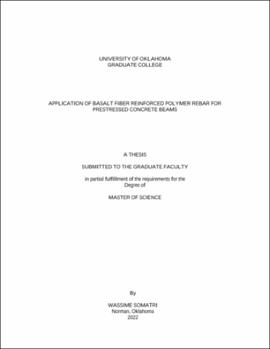| dc.description.abstract | All steel reinforced concrete infrastructure that is facing a chemical environment and
corrosion will have their service life greatly reduced. With time it will lead to a premature and an
inevitable failure of the steel reinforced members. After the World War II in the 1940s, the
development of fiber reinforced polymer (FRP) composites has found extensive applications in
different fields such as aerospace and the defense industry thanks to the expanded use of composites
and recently it has found applications in the construction industry. FRP composites are
characterized by various beneficial features such as high strength-to-weight ratios and excellent
corrosion resistance and can be used as a substitute for steel.
This research focused on investigating the implementation of a new materiel, basalt fiber
reinforced polymer (BFRP) for prestressed concrete members. Using BFRP rods instead of
traditional prestressing steel tendons could increase the durability of reinforced concrete structures.
To assess the behavior of prestressed members made with tensioned BFRP rods, and determine if
it would be suitable for prestressing applications, three prestressed BFRP concrete beams were
fabricated. For each one, a companion nonprestressed BFRP concrete beam was fabricated at the
same time. The nonprestressed BFRP concrete beams had the same characteristics as the
prestressed BFRP concrete beams. This would enable an assessment of the effectiveness of BFRP
for prestressing.
After developing an anchoring system using a steel sleeve that will confine the BFRP rod
from slipping through an expansive mortar, the prestressed BFRP beams could be fabricated. The
transfer length as well as the prestress losses were measured through the use of DEMEC points.
The transfer length results were dispersed depending on the method used to calculate them.
Prestress losses were also evaluated, and a prestress loss of approximately 10% was observed after
28 days. The results of the flexural testing of the beams lead to a conclusion that prestressed BFRP
concrete beams are 20% stronger than nonprestressed ones, and they could sustain a load five times
greater before the appearance of cracks in the prestressed BFRP concrete beams. As a result, BFRP
prestressed concrete beams will have a greater service life expectancy than regular reinforced
BFRP members. | en_US |
